Male Reproductive System: In pelvic region.
- testes + accessory ducts + glands + external genitalia.
1. Testes: Outside abdominal cavity within scrotum.
- Scrotum: Maintain low temperature of testes (2-2.5°C lower than internal body temperature) required for spermatogenesis.
- Oval in shape, length 4-5 Cm, width 2-3 cm
- Has 250 testicular lobules (each has 1-3 highly coiled seminiferous tubules).
- Seminiferous tubules: Production of sperms occur, lined by spermatogonia and Sertoli cells.
- Spermatogonia (male germ cell)- undergo meiotic division for sperm formation.
- Sertoli cells: Provide nutrition to germ cells.
- Interstitial space: Region outside seminiferous tubules, contain small blood vessel and interstitial cells / Leydig cell. (synthesise and secrete androgens)

2. Accessory Ducts:
- Seminiferous tubules open into vasa efferentia through rete testis.
- Vasa efferentia leave testis and open into epididymes on posterior of each testes, which leads to vas deferens that ascends to abdomen.
- Urinary bladder receives duct from seminal vesicle and open into urethra as ejaculatory duct (stores and transport sperms from testis to outside urethra).
- Urethra extends through penis to its external opening-urethral meatus.
3. Glands: Paired seminal vesicle, prostate and bulbourethral.
- Secretions of all 3- seminal plasma (rich in fructose, calcium, certain enzymes).
- Secretion of bulbourethral helps in lubrication of penis.
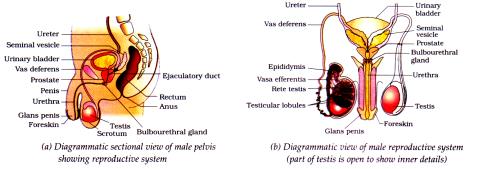
Female Reproductive System: In pelvic region.
- Pair of ovaries + oviducts + uterus + cervix + vagina + external genitalia
- These parts along with mammary gland play structural and functional role in ovulation, fertilization , birth, pregnancy.
1. Ovaries: Primary female sex organs, produce ovum and hormones.
- Located on each side of lower abdomen.
- 2-4 cm length, covered by epithelium enclosing ovarian stroma.
- Stroma is divided to peripheral cortex and inner medulla.
2. Female Accessory Ducts: Oviduct + uterus + vagina.
(a) Oviducts (fallopian tube)- 10-12 cm long.
- Isthmus: Narrow lumen, joins uterus.
- Ampulla: Middle wider part.
- Infundibulum: Close to ovary, funnel shaped, its edges possess finger like projections- fimbrae (collect ovum after ovulation).
(b) Uterus: (womb), single, inverted pear like.
- Has 3 tissue layers-
- Perimetrium: External thin membranous
- Myometrium: Middle thick layer of smooth muscle, contract during delivery.
- Endometrium: Inner glandular layer, undergo cyclical changes during menstrual cycle.
- Opens into vagina through narrow cervix.
- Cavity of cervix (cervical canal) + vagina = Birth canal.
3. External Genitalia: Mons pubis + Labia majora + Labia minora + Clitoris + Hymen.
- Mons pubis: Cushion of fatty tissues covered by skin and pubic hairs.
- Labia majora: Fleshy folds of tissue surrounding vaginal opening.
- Labia minora: Paired tissue folds under labia majora.
- Clitoris: Tiny finger like structure at upper junction of 2 labia minora.
- Hymen: Partial covering of membrane over vaginal opening. Is hymen sign of virginity?
- No, its not a reliable indicator of virginity.
- Its often broken during first coitus but may persist even after coitus in some women.
- It can also be broken by sudden fall, insertion of tampon, cycling, horseback riding.

4. Mammary Glands: Characteristic of female mammals, paired.
- Have glandular tissue and fat.
- Glandular tissue is divided into 15-20 mammary lobes containing clusters of cells- alveoli (secrete milk which is stored in lumen of alveoli).
- Alveoli ® mammary tubules ® mammary duct ® mammary ampulla ® lactiferous ducts (through which milk is sucked out).
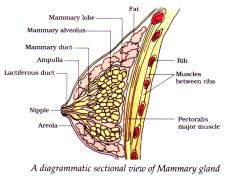
Gametogenesis: Production of male and female gametes.
1. Spermatogenesis: In males at puberty.
- immature male germ cells (spermatogonia) produce sperms.
- Spermatogonia (diploid, 46 chromosomes) on inner wall of seminiferous tubules multiply by mitotic division and some are called primary spermatocytes, which completes 1st meiotic division (reduction division) to form 2 equal secondary spermatocytes (haploid), which undergo 2nd meiotic division to produce 4 equal spermatids (haploid).
- Spermiogenesis: Spermatids are transformed to spermatozoa (sperms).
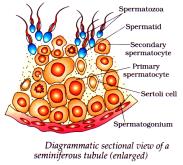
- Spermiation: after spermatogenesis, sperm head remains embedded in Sertoli cells and then released by seminiferous tubules.
- Hormonal Influence: by hypothalmic hormone (gonadotropin releasing hormone)
- Act at anterior pituitary and stimulate Luteinising hormone (LH) and follicle stimulating hormone (FSH).
- LH: Act at Leydig cells, stimulate synthesis and secretion of androgens, which stimulate spermatogenesis.
- FSH: Act at Sertoli cells, help in spermiogenesis.
- Structure of Sperm: head + neck + middle piece + tail.
- Plasma membrane envelops it.
- Head: Has elongated haploid nucleus, anterior portion is covered by cap like acrosome (filled with enzyme helping in fertilisation of ovum).
- Middle Piece: Has numerous mitochondria possessing energy for tail movement facilitating sperm motility.
- Male ejaculates 200-300 million sperms during coitus.
- For normal fertility, 60% of it must have normal shape and size and 40% of them must show vigorous motility.
- Seminal Plasma: Secretion of epididymis, vas deferens, seminal vesicle and prostate, essential for maturation and sperm motility.
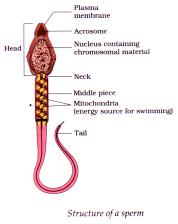
- Semen: Seminal plasma + sperms.
2. Oogenesis: In females.
- Initiated during embryonic development stage.
- Million of oogonia are formed in each ovary and no more oogonia are formed after birth.
- They divide and enter prophase I and get arrested at that stage primary oocyte.
- It gets surrounded by granulosa cells- primary follicle.
- A large no. of follicles get degenerate and only 60,000 - 80, 000 follicles are left in each ovary.
- Primary follicles get surrounded by more layers- secondary follicle.

- Fluid filled cavity (antrum) is formed- tertiary follicle. Theca layer is organised to inner theca and outer theca.
- Primary oocyte within tertiary follicle completes 1st meiotic division forming large secondary oocyte (n) and tiny first polar body as secondary oocyte retains bulk of nutrient rich cytoplasm.
- Tertiary follicle changes to graffian follicle. Secondary oocyte forms new membrane- zona pellucida.
- Ovulation: Graffian follicle ruptures to release secondary oocyte.
Spermatogenesis and Oogenesis:
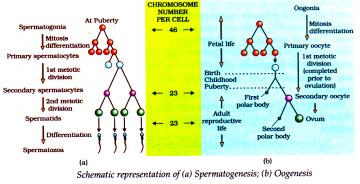
Menstrual Cycle: Reproductive cycle in female primates.
- Menarche: First menstruation at puberty.
- Its repeated at average interval of 28/29 days.
1. Menstrual Phase: 3-5 days.
- Menstrual flow occurs due to breakdown of endometrial lining of uterus and blood vessels which come out through vagina as liquid.
- Only occurs if released ovum isn’t fertilised
- Lack of it is indicative of pregnancy but it may also be due to stress, poor health etc.
2. Follicular Phase or proliferative Phase:
- Primary follicles grow to become fully mature Graffian follicle.
- Endometrium layer regenerates.
- Secretion of gonadotropins (LH and FSH) increases, stimulates secretion of estrogen and follicular development.
3. Ovulatory Phase: 14th day of cycle.
- LH and FSH attain peak level, leading to LH Surge.
- Graffian follicle ruptures and ovum releases: Ovulation.
4. Luteal Phase:
- Remaining graffian follicle transform as corpus luteum, which secretes large amount of progestrone for maintaining endometrium.
- In absence of fertilisation, corpus luteum degenerates, endometrium disintegrate leading to menstruation.
- During pregnancy, all events stop.
- Menopause: Menstrual cycle ceases around 50 years of age.
- These all events are result of pituitary and ovarian hormones.
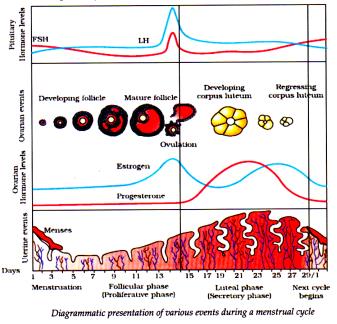
Fertilization and Implantation:
- Insemination: Release of semen into vagina by penis (during coitus).
- Sperm pass through cervix to uterus to ampullary region of fallopian tube.
- Ovum is also transported there and fertilization occur only if both are transported simultaneously.
- Fertilization: Fusion of sperm and ovum.
- Sperm comes in contact with zona pellucida and induce changes in membrane which block entry of additional sperms. So, 1 sperm can fertilise ovum.
- Secretion of acrosome help sperm to enter cytoplasm of ovum.
- Secondary oocyte complete meiotic division forming haploid ovum (n) and second polar body.
- Haploid nucleus of sperm fuse with ovum to form zygote (2n).
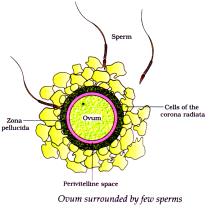
- Sex determination: Female (XX) and male (XY) - chromosome pattern.
- Haploid gamete of female have ‘X’ whereas males can have ‘X’ or ‘Y’ (50%)
- After fusion, zygote can carry either XX or XY depending on sperm.
- Zygote carrying XX is female whereas XY is male.
- Sex of the baby is determined by father and not mother.
- Zygote moves through isthmus- cleavage and form 2, 4, 8, 16 daughter cells- blastomeres, embryo with 8-16 blastomeres- morula which divides and transforms to blastocyst.
- Blatomeres in blastocyst are arranged into outer layer- trophoblast (which gets attached to endometrium) and inner group of cells- inner cell mass (get differentiated as embryo), acts as stem cells.
- Uterine cells divide and cover blastocyst.
- Implantation: Embedding of blastocyst in endometrium which leads to pregnancy.
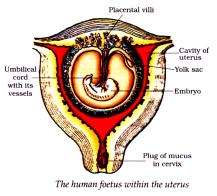
Pregnancy and Embryonic development:
- Finger like projections- chorionic villi appear on trophoblast, surrounded by uterine tissue and maternal blood.
- Placenta: Structural and functional unit between embryo and maternal blood, formed by chorionic villi and uterine tissue. It facilitate O2 and nutrient supply, removes CO2 and excretory waste of embryo, acts as endocrine tissue and produce hormones- human chorionic gonadotropin (hCG), human placental lactogen (hPL), estrogen, progestrone etc.
- hCG, hPL, relaxin (later pregnancy) are produced only during pregnancy.
- Others like estrogen, progestrone, cortisol, prolactin, thyroxine are in increased amount to support fetal growth, bring changes in mother and maintain pregnancy.
- Placenta is connected to embryo through umbilical cord which transports substances to and from embryo.
- Inner cell mass differentiate to outer ectoderm, inner endoderm and mesoderm in between which differentiate to tissues as they contain Stem cells which can give rise to all tissues and organs.
- Pregnancy last for 9 months in human.
- 1st month- embryo’s heart sound can be heard
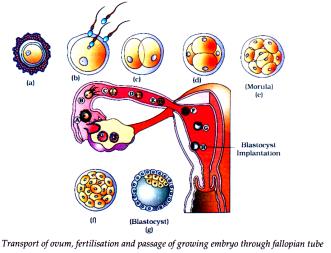
- End of 2nd month- foetus develops limbs and digits.
- First trimester (12 weeks)- organ system formed (limbs and external genital organs develop)
- 5th month- first movement of foetus, appearance of hair on head.
- End of second trimester- body is covered by fine hair, eye lids separate, eye lashes formed.
- End of 9th month- fully developed foetus.
Parturition and Lactation:
- Gestation period: Duration of human pregnancy (9 months)
- Parturition: Delivery of foetus, vigorous contraction of uterus causing expulsion of foetus.
- Signals for it originate from fully developed foetus and placenta which induce mild uterine contraction-foetal ejection reflex. It triggers oxytocin from maternal pituitary, which induces strong uterine contraction.
- Soon, after parturition, placenta is expelled out of uterus.
- Lactation: Mammary glands undergo differentiation during pregnancy and produce milk towards its end which helps in feeding new born.
- Colostrum: Milk produced during initial few days of lactation, has several antibodies (mainly IgA) and necessary for healthy baby.

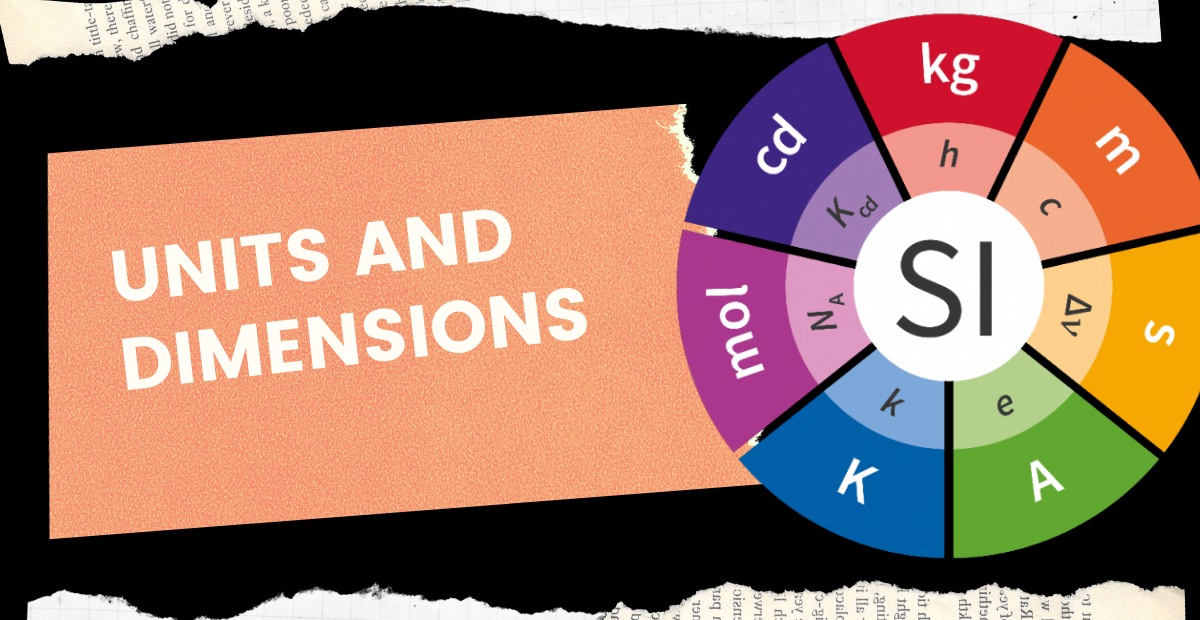
… [Trackback]
[…] Read More here on that Topic: eklabhyaclasses.com/blog/human-reproductive-system/ […]
… [Trackback]
[…] Find More on that Topic: eklabhyaclasses.com/blog/human-reproductive-system/ […]
… [Trackback]
[…] Here you can find 34520 additional Information on that Topic: eklabhyaclasses.com/blog/human-reproductive-system/ […]
… [Trackback]
[…] Find More to that Topic: eklabhyaclasses.com/blog/human-reproductive-system/ […]
… [Trackback]
[…] Here you will find 11298 more Info on that Topic: eklabhyaclasses.com/blog/human-reproductive-system/ […]
… [Trackback]
[…] Read More on that Topic: eklabhyaclasses.com/blog/human-reproductive-system/ […]
… [Trackback]
[…] Find More here on that Topic: eklabhyaclasses.com/blog/human-reproductive-system/ […]
… [Trackback]
[…] Read More here on that Topic: eklabhyaclasses.com/blog/human-reproductive-system/ […]
… [Trackback]
[…] Information on that Topic: eklabhyaclasses.com/blog/human-reproductive-system/ […]
… [Trackback]
[…] Information on that Topic: eklabhyaclasses.com/blog/human-reproductive-system/ […]
… [Trackback]
[…] Read More to that Topic: eklabhyaclasses.com/blog/human-reproductive-system/ […]
… [Trackback]
[…] Find More here to that Topic: eklabhyaclasses.com/blog/human-reproductive-system/ […]
… [Trackback]
[…] Read More on to that Topic: eklabhyaclasses.com/blog/human-reproductive-system/ […]
… [Trackback]
[…] Find More on to that Topic: eklabhyaclasses.com/blog/human-reproductive-system/ […]
… [Trackback]
[…] Find More Info here to that Topic: eklabhyaclasses.com/blog/human-reproductive-system/ […]
… [Trackback]
[…] Find More Info here to that Topic: eklabhyaclasses.com/blog/human-reproductive-system/ […]
… [Trackback]
[…] Read More on on that Topic: eklabhyaclasses.com/blog/human-reproductive-system/ […]
… [Trackback]
[…] Here you will find 6638 additional Information on that Topic: eklabhyaclasses.com/blog/human-reproductive-system/ […]
… [Trackback]
[…] Find More on that Topic: eklabhyaclasses.com/blog/human-reproductive-system/ […]
… [Trackback]
[…] Read More Info here on that Topic: eklabhyaclasses.com/blog/human-reproductive-system/ […]
… [Trackback]
[…] Read More to that Topic: eklabhyaclasses.com/blog/human-reproductive-system/ […]
… [Trackback]
[…] Find More to that Topic: eklabhyaclasses.com/blog/human-reproductive-system/ […]
… [Trackback]
[…] Find More on to that Topic: eklabhyaclasses.com/blog/human-reproductive-system/ […]
… [Trackback]
[…] Read More here to that Topic: eklabhyaclasses.com/blog/human-reproductive-system/ […]
… [Trackback]
[…] Here you will find 29957 additional Information on that Topic: eklabhyaclasses.com/blog/human-reproductive-system/ […]
… [Trackback]
[…] Here you can find 1501 more Information to that Topic: eklabhyaclasses.com/blog/human-reproductive-system/ […]
… [Trackback]
[…] Find More on to that Topic: eklabhyaclasses.com/blog/human-reproductive-system/ […]
… [Trackback]
[…] Read More Information here on that Topic: eklabhyaclasses.com/blog/human-reproductive-system/ […]
… [Trackback]
[…] Information to that Topic: eklabhyaclasses.com/blog/human-reproductive-system/ […]
… [Trackback]
[…] Find More Information here to that Topic: eklabhyaclasses.com/blog/human-reproductive-system/ […]
… [Trackback]
[…] There you can find 51800 additional Information to that Topic: eklabhyaclasses.com/blog/human-reproductive-system/ […]
… [Trackback]
[…] Find More Information here to that Topic: eklabhyaclasses.com/blog/human-reproductive-system/ […]
… [Trackback]
[…] Info on that Topic: eklabhyaclasses.com/blog/human-reproductive-system/ […]
… [Trackback]
[…] Read More to that Topic: eklabhyaclasses.com/blog/human-reproductive-system/ […]
… [Trackback]
[…] Find More Info here on that Topic: eklabhyaclasses.com/blog/human-reproductive-system/ […]
… [Trackback]
[…] Find More to that Topic: eklabhyaclasses.com/blog/human-reproductive-system/ […]
… [Trackback]
[…] Find More here to that Topic: eklabhyaclasses.com/blog/human-reproductive-system/ […]
… [Trackback]
[…] Read More on to that Topic: eklabhyaclasses.com/blog/human-reproductive-system/ […]
… [Trackback]
[…] Read More here to that Topic: eklabhyaclasses.com/blog/human-reproductive-system/ […]
… [Trackback]
[…] Read More on that Topic: eklabhyaclasses.com/blog/human-reproductive-system/ […]
… [Trackback]
[…] There you will find 79694 additional Information to that Topic: eklabhyaclasses.com/blog/human-reproductive-system/ […]
… [Trackback]
[…] Find More on to that Topic: eklabhyaclasses.com/blog/human-reproductive-system/ […]
… [Trackback]
[…] Find More to that Topic: eklabhyaclasses.com/blog/human-reproductive-system/ […]
… [Trackback]
[…] Read More Information here to that Topic: eklabhyaclasses.com/blog/human-reproductive-system/ […]